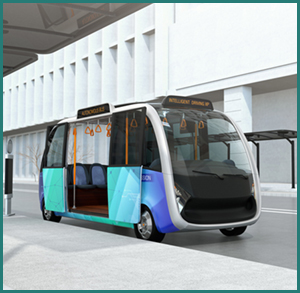Self-driving Vehicles
Self-driving vehicles (a.k.a. automated vehicles) have captured the public’s imagination for decades. Recent developments in sensors and artificial intelligence have resulted in new technologies that make this once science fiction-sounding idea much closer to reality. Many of today’s new vehicles already have “driver assist” capabilities, with fully automated vehicles under development.
 SAE International has defined five levels of automationExit, from Level 0 to Level 5, with Level 5 being full automation. The most advanced vehicles available today are already functioning at a Level 2, and many manufacturers are promising higher levels of automation in the near future.
SAE International has defined five levels of automationExit, from Level 0 to Level 5, with Level 5 being full automation. The most advanced vehicles available today are already functioning at a Level 2, and many manufacturers are promising higher levels of automation in the near future.
- Level 0 cars have no driving automation, though they may have some automated features. While the driver is always in full control of the car, the car might have some ability to provide safety warnings (e.g., a lane departure warning system) or momentarily intervene in driving (e.g., automated emergency braking).
- Level 1 automation is considered driver assistance. The car can control either speed or steering, but not both at the same time. Adaptive cruise control and lane assist technology are examples of Level 1 automation technology.
- Level 2 automated cars can control both speed and steering at the same time, but only under certain conditions, such as below a set speed limit. A car operating at Level 2 could have both adaptive cruise control and lane centering technologies working simultaneously. Another example technology is parking assistance (or self-parking). A driver in a Level 2 automated car needs to be fully alert, monitor their surroundings (essentially supervising the driving automation system), and ready to take over driving if needed.
- Level 3 automation is known as “conditional automation.” The car can control both its speed and steering at the same time, and can monitor its surroundings, so it is able to drive on its own under certain conditions. The human driver still needs to be paying attention, but the car will typically alert the driver if they need to take over control because the car is no longer in conditions it can handle. A Level 3 car could, for example, drive through a traffic jam on a highway, but a human driver would be expected to drive the car to and from the highway.
- Level 4 automated cars are highly automated, self-driving, and able to handle most normal driving conditions. If the car is in a situation where the automated system cannot drive (like extreme weather), it will implement safety measures such as pulling over and stopping, rather than requiring the human driver to take over.
- Level 5 is the highest level of automation and is considered “full automation.” A Level 5 automated car can drive itself in all conditions.
 |
 |
 |
 |
 |
 |
|
|---|---|---|---|---|---|---|
| Level of Automation | None | Driver Assistance | Partial | Conditional | High | Full |
| Requires human driver? | Yes | Yes | Yes | Yes | No | No |
| Control speed? | No | Yes, but not at same time as steering |
Yes, under certain conditions |
Yes, under certain conditions |
Yes, under certain conditions |
Yes |
| Control steering? | No | Yes, under certain conditions |
Yes, under certain conditions |
Yes, under certain conditions |
Yes, under certain conditions |
Yes |
| Aware of driving environment? | No | No | No | No | No | Yes |
| Actions in conditions it cannot drive in (e.g., bad weather) |
N/A – Human driver in control |
N/A – Human driver in control |
Human driver must decide conditions are not appropriate and take control |
Alerts human driver to take control |
Implements safety procedures |
N/A – Able to drive in all conditions |
Self-driving cars have the potential to drastically change both how people get around and the related environmental impact of people’s transportation and travel choices. Many of these impacts remain uncertain, but EPA continues to follow the developments in self-driving car technologies, policies, regulations, and environmental impacts to help make transportation cleaner and safer for everyone.
